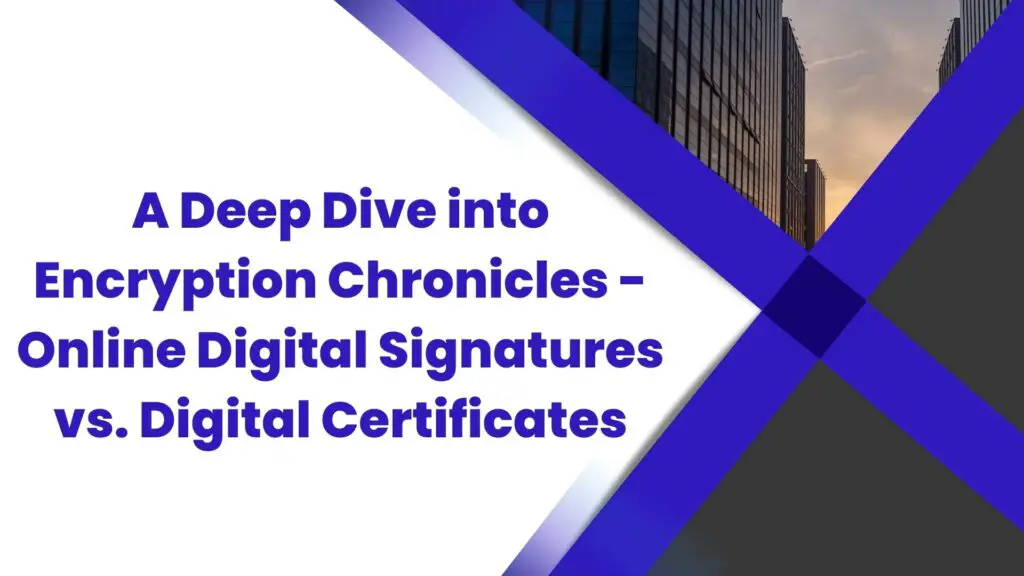In the rapidly evolving landscape of digital communication and information exchange, the paramount importance of securing sensitive data cannot be overstated. Encryption stands as the stalwart guardian of our digital realm, and within its arsenal, two key players take center stage: Online Digital Signatures and Digital Certificates. In this exploration into the Encryption Chronicles, we unravel the intricate dance between these formidable protectors, understanding their roles, strengths, and how they synergize to fortify the walls of our cyber kingdoms.
Table of Contents
ToggleIntroduction: The Pervasive Need for Digital Security
The proliferation of online transactions, sensitive communications, and digital interactions necessitates robust security measures to protect against unauthorized access, data tampering, and identity fraud. Enter Encryption – the art of transforming data into an unreadable format that can only be deciphered by those with the appropriate decryption keys.
The Sentinel – Online Digital Signatures
Defining the Digital Signature
Digital signatures serve as the digital counterpart to handwritten signatures, providing authenticity, integrity, and non-repudiation to electronic messages and documents. Utilizing asymmetric key cryptography, digital signatures leverage a private key to sign data. And a corresponding public key to verify the signature.
How Online Digital Signatures Work
When a sender affixes a digital signature to a document or message, the recipient can use the sender’s public key to verify the signature’s authenticity. Any tampering with the data would render the signature invalid, ensuring the integrity of the information. This process establishes trust and accountability in the digital realm.
Strengths and Limitations
Online Digital Signatures excel in scenarios where document integrity and the identity of the sender are critical. However, they do not inherently address the broader need for verifying the identity of parties involved in digital transactions.
The Guardian – Digital Certificates
Introduction to Digital Certificates
Digital Certificates function as virtual passports in the digital world, verifying the identity of entities involved in online communication. Issued by trusted Certificate Authorities (CAs), these certificates bind a public key to an individual, device, or service, vouching for their authenticity.
The Role of Certificate Authorities
Certificate Authorities play a pivotal role in the issuance and validation of digital certificates. By maintaining a public key infrastructure (PKI), CAs ensure the security and trustworthiness of the digital certificate ecosystem.
Comprehensive Security with Digital Certificates
Digital Certificates go beyond the scope of Online Digital Signatures by providing a holistic approach to digital security. They not only validate the origin of a message through the public key but also establish a secure channel for communication, mitigating the risks associated with impersonation and man-in-the-middle attacks.
Synergy in Action – Harmonizing Online Digital Signatures and Digital Certificates
The Symbiotic Relationship
While Online Digital Signatures and Digital Certificates serve distinct purposes, their combination offers a comprehensive security solution. Digital signatures verify the integrity and authenticity of specific messages or documents. While digital certificates validate the overall identity and trustworthiness of the parties involved.
Implementing a Secure Ecosystem
In practice, organizations often deploy both technologies in tandem. Digital certificates authenticate the parties engaging in communication, and digital signatures ensure the integrity of the exchanged information. This synergistic approach creates a robust defense against cyber threats and establishes a foundation of trust in digital transactions.
Conclusion: Safeguarding the Digital Frontier
As we navigate the digital landscape, the Encryption Chronicles spotlight the indispensable roles played by Online Digital Signatures and Digital Certificates. In a world where cyber threats loom large, these cryptographic guardians stand as sentinels, protecting our data, communications, and transactions. By understanding their strengths and fostering their collaboration, we forge a resilient shield against the ever-evolving challenges of the digital realm. The Encryption Chronicles continue to unfold, as the quest for secure, trustworthy communication in the digital era persists.




